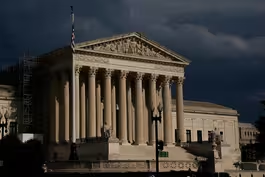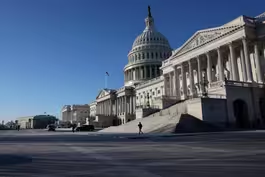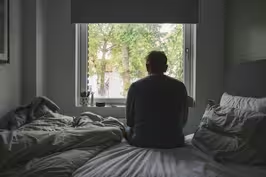
Schools work to help students amid chronic absenteeism rise
Clip: 1/17/2024 | 5m 21sVideo has Closed Captions
School leaders work to keep students in class amid rise in chronic absenteeism
Chronic absenteeism is a problem for school districts and students and the situation has grown significantly worse since the pandemic. Nearly 30 percent of students were chronically absent during the 2021-2022 school year, missing at least 10 percent of school days. Communities Correspondent Gabrielle Hays joined Geoff Bennett to discuss how schools in Missouri are struggling with it.
Problems playing video? | Closed Captioning Feedback
Problems playing video? | Closed Captioning Feedback
Major corporate funding for the PBS News Hour is provided by BDO, BNSF, Consumer Cellular, American Cruise Lines, and Raymond James. Funding for the PBS NewsHour Weekend is provided by...

Schools work to help students amid chronic absenteeism rise
Clip: 1/17/2024 | 5m 21sVideo has Closed Captions
Chronic absenteeism is a problem for school districts and students and the situation has grown significantly worse since the pandemic. Nearly 30 percent of students were chronically absent during the 2021-2022 school year, missing at least 10 percent of school days. Communities Correspondent Gabrielle Hays joined Geoff Bennett to discuss how schools in Missouri are struggling with it.
Problems playing video? | Closed Captioning Feedback
How to Watch PBS News Hour
PBS News Hour is available to stream on pbs.org and the free PBS App, available on iPhone, Apple TV, Android TV, Android smartphones, Amazon Fire TV, Amazon Fire Tablet, Roku, Samsung Smart TV, and Vizio.
Providing Support for PBS.org
Learn Moreabout PBS online sponsorshipacross the country.
While some states# have seen modest gains, the situation## has grown significantly worse since the pandemic.
Nearly 30 percent of students were# chronically absent during the and 2022 school year.
That's according to the# most recent federal data.
And it's defined a missing at least 10 percent of school days.# It can have major consequences for student## achievement and much more, and many districts# are struggling with it, including Missouri.
Our communities correspondent, Gabrielle# Hays, joins us now from St. Louis.
Gabby, it's good to see you.
So give across the country, based on your reporting.
GABRIELLE HAYS: Yes, absolutely, Geoff.
Well, I think it's important to national data.
It's not much better, but# it hasn't gone back to what it was.
So,## the most recent numbers that we have# seen from our state report card point## to nearly a quarter of our students# across state of Missouri being absent.
Now, if we're comparing this year to last year,# as you have noted, what we're seeing nationwide,## we have seen very, very modest gains.
But, again,# the place of concern for our school administrators## and our experts is that those numbers have# not returned to what they were pre-pandemic.
And that is something that is especially of# concern, not just in Missouri, but nationwide,## so much so that we have seen the White House come# out on this, not just last year, but even today,## emphasizing the issue of chronic absenteeism# across the states and across the country.
GEOFF BENNETT: What did they say about# the impact that absenteeism is having?
GABRIELLE HAYS: Yes.
across the country, and they note just how big# this issue is of chronic absenteeism and what it## means for students across the country.
They really# honed in on the fact that, how can our nation's## students learn if they're not in the classroom,# and emphasize the need for some side of -- some## sort of road map to help states navigate# some accountability when it comes to that.
But we heard especially from domestic# policy adviser Neera Tanden on this.
NEERA TANDEN, White House Domestic# Policy Adviser: Absenteeism can## account for up t we have seen and 45 percent of the test# score declines in reading respectively.
We know that from the Council of Economic Advisers# and deep research they have done.
The truth is,## we simply cannot accept chronic# absenteeism as the new normal.
GABRIELLE HAYS: Now, I want to emphasize something# that I heard not just from school administrators,## not just from the state, and# not just from the White House,## but from researchers that# have emphasized this as ar e these long, far-reaching impacts of chronic# absenteeism and what that can mean to stud And they have linked this not only to# things like its effects on mental health,## but also the ability of a person# to earn a living long term.
GEOFF BENNETT: So, what are the barriers# keeping students out of the classroom then?
GABRIELLE HAYS: That's a really good question.
I think one thing that I - out to me and experts is that we're# talking about barriers that young## people faced even before the pandemic that# the pandemic maybe made Attendance Works, which is a national organization# that works at this issue, caused them root causes.## So we're talking about anything from child# abuse, to not having access to transportation,## to not having access to stable housing.
So, if you# add a global pandemic to all of these root causes,## it makes for a very rough scenario for a lot of# our young people who are not showing up to school.
Hedy Chang, the executive# director of Attendance Works,## spoke to me about this and of the importance# of understanding HEDY CHANG, Executive Director,# Attendance Works: A major challenge## in our work on -- around of ten, in this country, we think it's# because a kid and family doesn't care.
This is not about whether you care# or not.
This is about whether you## face barriers or challenges# and issues coming to school.
GABRIELLE HAYS: This is a big thing# that Chang stressed to me, in order to really take a look at this# issue, it ha The numbers are a good start, but# it has to go beyond the numbers## and misconceptions about why# young people aren't at school.
GEOFF BENNETT: So, how are schools handling# this?
And what do expe GABRIELLE HAYS: Yes, well, I think, on one hand,## school districts have told me they're# really just trying and learn as best they can why students# aren't showing up, so they can help them.
But Chang really emphasized to me that there# needs to be more data.
There needs to be more## investigation into what this looks like and why# it looks like it, so that, once we have all of## the numbers to know how far this goes, that# we can work together to solve it and really## attack this as a case-by-case basis, because every# student is different and every story is different.
GEOFF BENNETT: Our communities correspondent,# Gabrielle Hays, in St. Louis, thanks so much.
Artist reflects on natural beauty with a knife and paper
Video has Closed Captions
Clip: 1/17/2024 | 7m 21s | Artist reflects on the natural beauty of the Pacific Northwest with a knife and paper (7m 21s)
Case involving a fish could curtail federal regulations
Video has Closed Captions
Clip: 1/17/2024 | 6m 34s | How a case involving a small fish could have big implications on federal regulations (6m 34s)
Congress, White House negotiate Ukraine and border funding
Video has Closed Captions
Clip: 1/17/2024 | 4m 36s | What’s in the way of a deal as Congress, White House negotiate Ukraine and border funding (4m 36s)
Former NATO head on U.S. debate over Ukraine military aid
Video has Closed Captions
Clip: 1/17/2024 | 6m 51s | Former NATO chief on what's at stake as U.S. debates military aid for Ukraine (6m 51s)
Growing number of men say they are in a friendship recession
Video has Closed Captions
Clip: 1/17/2024 | 8m 13s | Why a growing number of American men say they are in a 'friendship recession' (8m 13s)
U.S. official overseeing Yemen discusses response to Houthis
Video has Closed Captions
Clip: 1/17/2024 | 7m 34s | State Department official overseeing Yemen discusses U.S. response to Houthi attacks (7m 34s)
Providing Support for PBS.org
Learn Moreabout PBS online sponsorship
- News and Public Affairs

FRONTLINE is investigative journalism that questions, explains and changes our world.

- News and Public Affairs

Amanpour and Company features conversations with leaders and decision makers.












Support for PBS provided by:
Major corporate funding for the PBS News Hour is provided by BDO, BNSF, Consumer Cellular, American Cruise Lines, and Raymond James. Funding for the PBS NewsHour Weekend is provided by...





